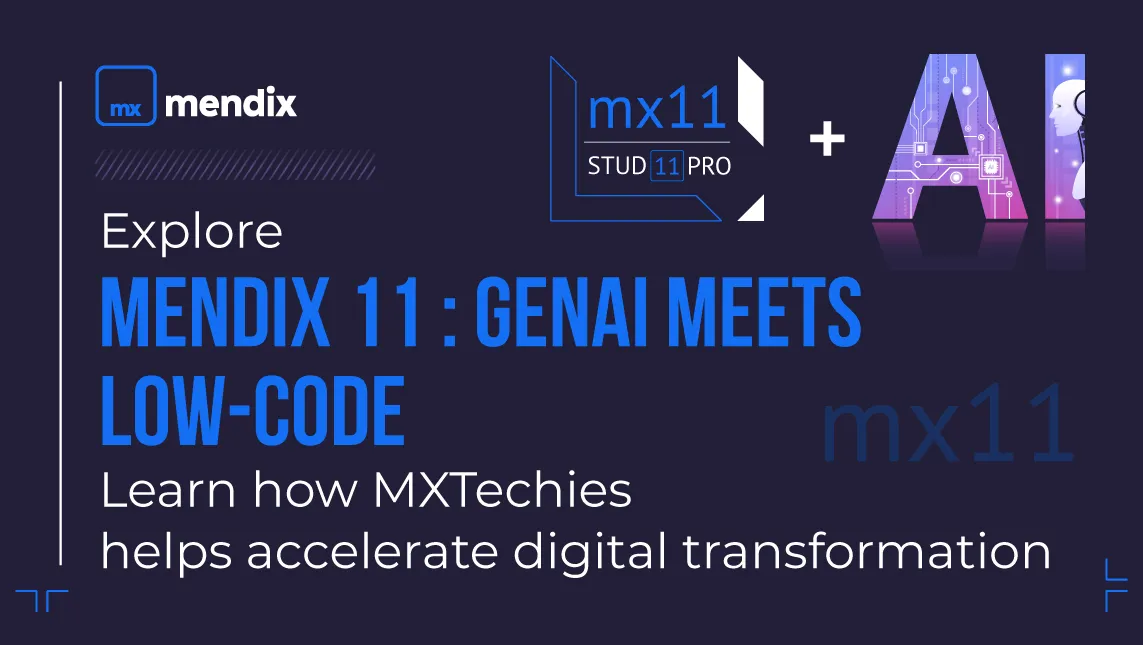Mendix 11: GenAI Meets Low-Code – A Leap Forward for Enterprise App Development

At MXTechies, we always keep a close eye on Mendix updates to stay ahead in the low-code game — and Mendix 11 has truly impressed us. It’s not just a version update; it’s a clear shift in how low-code platforms are expected to operate in an AI-driven, enterprise-grade ecosystem.
In this blog, we explore the highlights of Mendix 11 and share our thoughts on what it means for developers, enterprises, and digital innovation.
What Stood Out Most?
The “Start with Maia” feature is undoubtedly the showstopper. Maia creates the following with only a word description and, if available, an image or PDF:
Domain models
-
Data management pages
-
Test data
-
A tailored homepage
This isn’t just helpful — it’s revolutionary. It eliminates the inertia that is frequently seen at the start of the development process. In seconds, you move from an idea to a tangible foundation for your app.
We also loved the Maia for Workflows, allowing workflows to be generated from prompts. This cuts down the complexity of process modeling and encourages rapid experimentation.
Biggest Improvements by Area
AI / GenAI:
Maia has progressed from being new to being essential. It’s now embedded in app generation and workflow automation.
User Experience:
The logic editor refinements and updated dialogs (like "Go to...") feel smoother and more intuitive.
Deployment & Runtime:
React client logging, task queue optimizations, and error handling provide more robustness during deployment and runtime.
Versioning:
Workflow version conflict analysis now performs better for large workflows with multiple outcomes.
Thoughts on Mendix GenAI Capabilities
Maia isn’t just a buzzword. It feels genuinely helpful — not just in auto-generating boilerplate, but in making smart architectural suggestions. Whether it’s generating domain models or building workflows, Maia bridges the gap between business thinking and app execution.
From a business analyst’s requirement to a developer’s screen — in minutes.
Meeting Enterprise Expectations
Mendix 11 aligns perfectly with what today’s enterprises demand:
-
Faster time to market
-
AI-powered automation
-
Adaptable low-code tooling
-
Cleaner, modernized UX for secure collaboration
The deprecation of legacy tools like the Dojo client and document templates also reflects Mendix’s commitment to clean and scalable development.
Risks, Limitations & Learning Curve
With great power comes a few caveats:
-
Learning curve for GenAI : While powerful, Maia requires a good grasp of app logic to interpret and refine its outputs.
-
Deprecations : Legacy tools being phased out may cause temporary disruption if not migrated proactively.
-
Model governance : With auto-generated logic, teams need proper validation frameworks to ensure quality and consistency.
But with awareness and guidance, these can be easily mitigated.
Want to Learn More About Mendix 11?
Mendix 11 is packed with GenAI-powered tools, improved low-code capabilities, and smarter automation features — but how do you make the most of it for your business?
Our Mendix experts at MXTechies are here to guide you — whether you're planning new app development or upgrading existing systems.
Talk to a Mendix ExpertFinal Thoughts
Mendix 11 expands the definition of low code. With GenAI-powered features, modernized tooling, and performance optimizations, it is a clear signal that the future of app development is fast, smart, and scalable.
At MXTechies, we’re excited to leverage these features not just for ourselves, but for our customers across manufacturing, PLM, and IoT. Whether you’re starting from scratch or modernizing legacy systems — Mendix 11 has something powerful to offer.